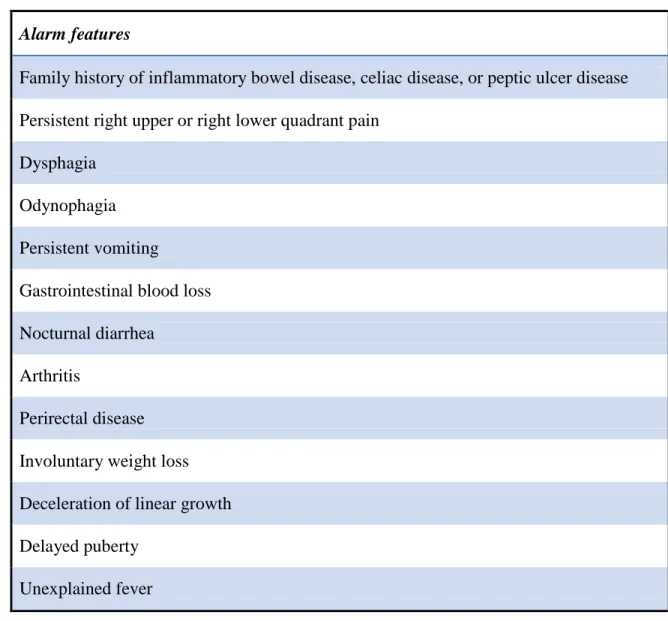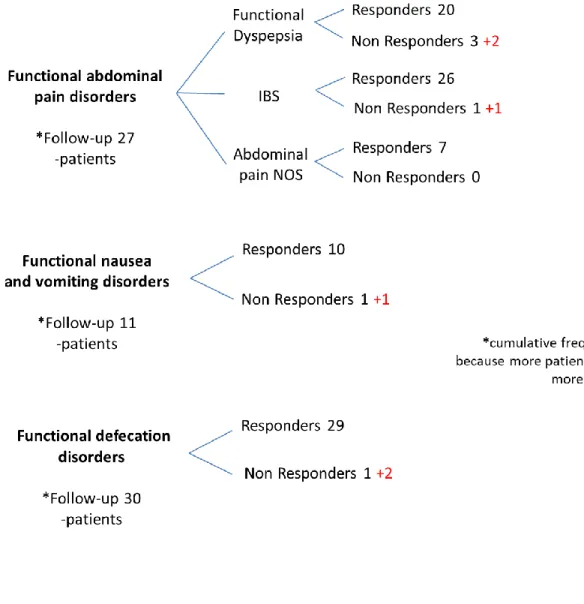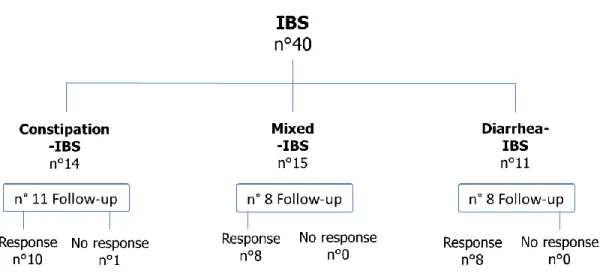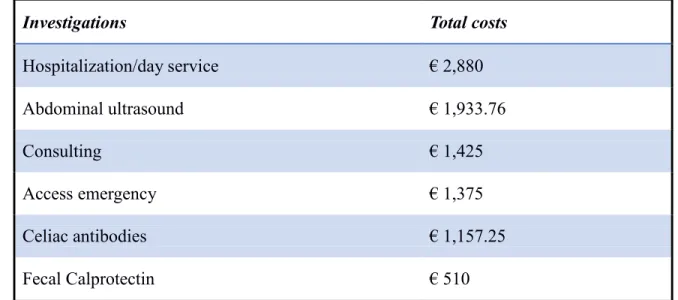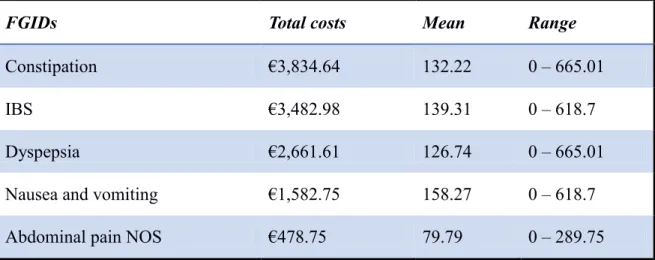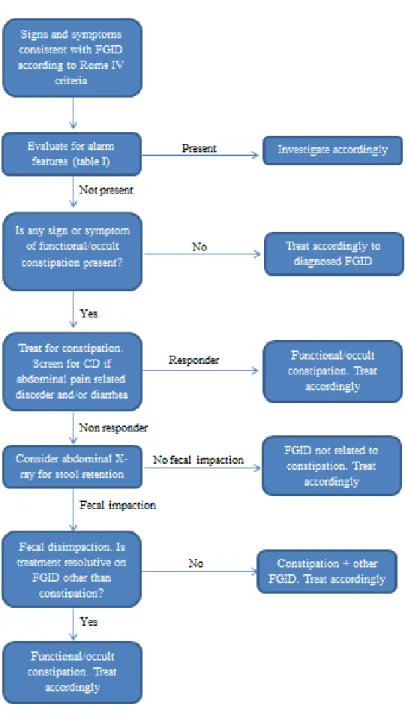UNIVERSITY OF MESSINA PhD Program XXXI Cycle Medical and Surgical Biotechnologies Coordinator: Prof. Giovanni Raimondo
RELEVANCE AND COSTS OF CONSTIPATION AS THE ONLY CAUSE
OF FUNCTIONAL GASTROINTESTINAL DISORDERS IN
CHILHOOD: PROSPECTIVE OBSERVATIONAL STUDY IN CLINICAL
PRACTICE
PhD thesis of: Dr. Roberto Conti Nibali
Tutor:
Prof. Giuseppe Magazzù
I
TABLE OF CONTENTS
TABLE OF CONTENTS I ABSTRACT 1 INTRODUCTION 3 METHODS 5 RESULTS 10 DISCUSSION 17 CONCLUSIONS 26 REFERENCES 271
ABSTRACT
BACKGROUND:
Functional gastrointestinal disorders (FGIDs) are common in children of all ages and have a considerable impact on the patient’s quality of life, on the families and on the health care system costs. Recent data indicate that both overt and occult constipation may have a causative role in most cases.
OBJECTIVE:
The main objective is to establish the prevalence of both overt and occult constipation as the only cause of most FGIDs.
DESIGN:
Observational prospective study. All patients with overt or occult constipation were treated with polyethylene glycol (PEG ) at disimpaction dose followed by maintenance dose and then reassessed at two months follow-up.
SETTING:
Tertiary pediatric gastroenterology outpatient clinic.
PARTECIPANTS:
All consecutive patients referred to the outpatient clinic between January and July 2018, aged 4-18 years, with FGIDs according to Rome IV criteria. Patients with gastrointestinal alarm features were excluded. Of 272 patients accessing the clinic, 209 were excluded because of not fulfilling the eligibility criteria, 63 consecutive patients were enrolled in the study, none refused to participate, 45 completed the follow-up up to now.
2
EXPOSURE:
Patients were treated with PEG 1.5 gr/Kg/day for 3 days, then with half dose for 2 months.
MAIN OUTCOMES AND MEASURES:
The hypothesis being tested was formulated before the data collection.
The main endpoint was defined as a decrease of more than an half in frequency and severity of FGIDs, by using pain severity and pain frequency scores.
RESULTS:
Prevalence of functional constipation (FC) according to Rome IV was 63.5%, PEG treatment prescribed to all patients suffering for at least one FGID was successful in 42 patients (93%). The difference between the prevalence of FC according to Rome IV criteria and the prevalence of constipation as the only cause of FGIDs was highly significant (p< 0.001).
CONCLUSION AND RELEVANCE:
Results support the hypothesis that overt or occult constipation is the main significant cause of most FGIDs. For the first time, results highlight the relationship between constipation and irritable bowel syndrome (IBS) with diarrhea and IBS mixed type. These findings may result in an improved management of children with FGIDs and in a
3
INTRODUCTION
Functional Gastrointestinal disorders (FGIDs) are a variable combination of chronic or recurrent gastrointestinal symptoms that after appropriate medical evaluation, cannot be attributed to another medical condition; FGIDs are currently classified according to the Rome IV criteria (Hyams et al.; 2016; Benninga et al. 2016).
FGIDs can often result in distress, reduced quality of life, a perceived lack of validation, as well as an unsatisfactory experience with health care providers (Houghton et al., 2016) and in high health care costs (Hoekman et al., 2015; Park et al., 2015; Sommers et al., 2015; Sethi et al., 2014).
They have a prevalence of 25% of children and adolescents aged 4-18 years, being functional constipation the most common disorder (18.5%) (Robin et al., 2018); in a substantial percentage of patients 2 or more disorders coexist (Zwiener et al., 2017) Functional constipation, is the only FGID to be consistently present throughout all the pediatric age (Benninga, 2016); children with functional constipation show a broad profile of gastrointestinal symptoms compared to healthy controls (Varni et al. 2015), and a correlation has been shown also in upper GI symptoms, as gastroesophageal reflux disease (Baran et al., 2017) and dyspepsia (Boccia et al., 2008).
Recent evidence suggests that occult constipation, intended as constipation that cannot be diagnosed according to current criteria for functional constipation but whose treatment resolves the symptoms, has been shown to have a causative role in a significant percentage of children presenting with abdominal pain (Eidlitz-Markus et. Al., 2004; Gijsbers et al., 2011; Gijsbers et al. 2014; Ha et al., 2017).
4
The main aim of this study is to establish the prevalence of both overt and occult constipation as the only cause of most of the functional gastrointestinal diseases: functional abdominal pain disorders, also including those of upper digestive tract, IBS-D
and IBS-M, and constipation.
Another aim of the study is to prospectively estimate costs of occult or not valued constipation, through a questionnaire about costs of investigation and treatment utilized before the diagnosis, in order to suggest a cheap empiric approach aimed at saving money.
5
METHODS
Study design
In a prospective observational study, we assessed the response of symptoms to constipation treatment in pediatric patients affected by FGIDs, regardless the initial diagnosis of functional constipation.
Rome IV Paediatric Diagnostic Questionnaire was used to diagnose of one or more FGIDs. Also, the following questions regarding occult constipation were asked:
history of constipation treated or not during the first 3 years of life;
presence of separate small hard lumps or constipation in some days and loose stools in other days;
soiling.
After filling up the clinical questionnaire, a structured questionnaire about costs of investigation and treatment utilized before the diagnosis was given and filled out by the caregivers.
In absence of alarm signals (table I) and in presence of persistent bowel movement pattern change, anti-tissue transglutaminase IgA antibodies (anti-tTG IgA) with total IgA were determined in all patients. In the suspicion of occult stool retention, a plain abdominal X-ray was performed.
6 Alarm features
Family history of inflammatory bowel disease, celiac disease, or peptic ulcer disease Persistent right upper or right lower quadrant pain
Dysphagia Odynophagia Persistent vomiting
Gastrointestinal blood loss Nocturnal diarrhea
Arthritis
Perirectal disease Involuntary weight loss Deceleration of linear growth Delayed puberty
Unexplained fever
Table I: Potential Alarm Features in Children with Chronic Abdominal Pain (Hyams et al, 2016)
Children who met the inclusion criteria were treated with PEG at a dose of 1.5 g/Kg for 3 days followed by half dose for 2 months when they were reassessed.
Participants and caregivers were asked to keep abdominal pain diary for two weeks, pre-treatment week and the last week of pre-treatment, in which they recorded intensity and
7 frequency of abdominal pain daily.
Occult constipation was diagnosed in children who became pain free with laxative therapy but did not fulfil the Rome IV criteria for functional constipation. In case of no response to oral laxatives, in presence of stool retention using plain abdominal X-ray, lavage of the colon was performed with polyethylene glycol solution.
We assessed the responses after follow-up at two months; outcomes were determined using questionnaires in order to obtain quantitative measures.
Setting
The study was conducted at the Pediatric Gastroenterology Outpatient Clinic at University Hospital Polyclinic G. Martino, in Messina, Italy, between January 2018 and July 2018.
Participants
All consecutive children referred to our outpatient clinic, aged 4-18 years, with gastrointestinal symptoms fulfilling Rome IV criteria for FGIDs, were eligible for inclusion in the study. Patients with known or suspected chronic disease (e.g. autism, inflammatory bowel disease, celiac disease), children with no functional disorder or with self-resolved symptoms, patients suffering from Cyclic Vomiting Syndrome (except for children in whom organic causes had been already ruled out in presence of functional constipation) were excluded from the study.
A clinical outpatient visit was set up at two months from the start of the treatment and consisted in a clinical evaluation and in the measurement of the outcome of treatment.
8 Measurement
Pain score was used as an instrument to measure the treatment response in patients with functional abdominal pain disorders.
Pain intensity was scored using the validated Faces Pain Scale-Revised (Hicks et al., 2001), and consists of six facial expressions for the degree of pain, ranging from 0 (=no hurt) to 10 (hurts the worst). Children were asked to choose the facial expression that best described the pain they felt. Pain frequency was scored as follow: 0=no pain, 1=less than 20 minutes a day, 2=more than 20 minutes a day, 3=more than 40 minutes a day, 4=more than 90 minutes a day (Korterink et al., 2016). The daily scores were added up, and the mean week scores were used to obtain a pain intensity score and a pain frequency score for these different time points.
Bias
In order to avoid selection bias, all patients who fulfilled the inclusion criteria were proposed to enroll in the study; none refused the participation.
Sample size estimation and statistics
About the prevalence of constipation, the main outcome, it was expected a prevalence of 45% of constipation as the cause of FGIDs, excluding functional constipation, due to which the children were going to be enrolled.
The prevalence of constipation in paediatric population is 29%. In our study, considering an expected prevalence of 45% of constipation as the cause of FGIDs in the enrolled children, in order to obtain a p-value<0.05 statistically significant at a two-tailed test, the
9
minimum number of children needed to be enrolled was 67 (increased to 81 children in order to a potential 20% drop-out).
In the study, the categorical variables are expressed as number and percentage, while numeric variables are expressed as statistical average, median, standard deviation (SD), minimum and maximum.
Kolmogorov–Smirnov test has been used to verify the normal distribution of numeric variables.
A parametric or non-parametric approach was planned to be performed, respectively in the case of normal or non-normal variables obtained, with a subsequent application of a correlation test between variables and a test to compare constipated and non-constipated patients.
In order to verify the influence of constipation and of other potential factors on FGIDs, regression models were planned to be used, accordingly to the distribution of the variable outcomes.
Univariate models were to be applied first and, on the basis of the possible significance, a multivariate model was estimated.
Furthermore, the costs of occult constipation were analyzed using a structured questionnaire on the costs of diagnostic tests and treatments performed prior to diagnosis.
The defined significance level was determined as α=0.050; p-values lower than 0.050 in the two-tailed tests were then planned to be considered statistically significant.
10
RESULTS
During a six months period, 272 pediatric patients were referred to the outpatient clinic; 63 patients were eligible for enrolment in study; all of them accepted the participation, and an informed consent form was signed by the caregivers; 45 completed the follow-up at two months. At the first consultation functional constipation was present in 40 patients (in 36/40 patients it was associated to other FGIDs); among other FGIDs, 16 patients presented nausea and functional vomiting disorders, 31 presented functional dyspepsia, 40 presented IBS and 9 presented abdominal pain not otherwise specified (NOS). Overall, the prevalence of functional constipation according to the Rome IV criteria was 40/63 (63.5% of patients).
11 Figure I. Study design and main results
IBS: irritable bowel syndrome. Abdominal pain NOS: abdominal pain, not otherwise specified. FGID: functional gastrointestinal disorder
The prevalence of functional constipation diagnosed according to Rome IV, at the outpatient clinic was 63.5% (40/63).
Among 30 patients with functional defecation disorders, who completed the follow-up, there were 29 who responded to treatment, 1 who was a non-responder; 2 patients dropped out.
12
was completely successful in 42 patients (93%) and, in addition to this, there were 2 patients in whom therapy was partially resolutive; these patients had relief from abdominal pain but not from dyspepsia or reflux.
The difference between the prevalence of constipation according to Rome IV criteria (63.5%) and the prevalence of constipation as the only cause of FGIDs (93%) was highly significant (p < 0.001).
In 1 patient treatment failed and in 3 patients no conclusion was possible to draw because their adherence to therapy was insufficient. They failed to comply with the prescribed treatment because of the refusal of the children towards PEG.
We have considered these patients to be non-responders.
All 42 patients who were pain-free with treatment for at least 2 months were considered as having under-reported or occult constipation as the cause of the gastrointestinal complaints. There was considerable variation over the time to obtain success; 3 patients needed colonic lavage to obtain resolution of symptoms.
The 45 children who completed a 2-month follow-up accounted for 72 functional disorders. Considering the whole spectrum of disorders, a positive response to the treatment was registered in 63 of the mentioned disorders. Therefore, the prevalence of constipation, under-reported or occult, as the only cause of the whole FGIDs, was 87.5% (63/72).
Of the 42 children who were successfully treated, 29 (69%) fulfilled Rome IV criteria for functional constipation and therefore were considered to have under-reported functional constipation. The other 13 children, who were pain-free after treatment but
13
did not fulfill the Rome IV criteria for functional constipation, were considered to have occult constipation.
Figure II shows the outcome of two months follow-up of 45 patients who accounted for 72 FGIDs, excluding functional constipation (drop outs are marked in red).
Figure II. Complete follow-up
IBS: irritable bowel syndrome. Abdominal pain NOS: abdominal pain, not otherwise specified. FGIDs: functional gastrointestinal disorders
14
Patients who met diagnostic criteria for IBS were classified according to the following subtypes: IBS with constipation (IBS-C), IBS with diarrhea (IBS-D) and IBS mixed-type (IBS-M), that is constipation alternate with diarrhea (figure III). Out of 27 patients who completed the 2-month follow-up only 1 patient with IBS-C did not respond to treatment for constipation.
Figure III. Distribution of IBS subtypes. IBS: irritable bowel syndrome.
Total costs of care were collected with the structured questionnaire in 53 children enrolled with overt (but unvalued) or occult constipation and were estimated to be €12,007.17.
For 10 recruited patients, parents did not bring any documentation regarding costs in 2; the other 8 children did not undergo any investigation to rule out the cause of the problem because of its remitting-relapsing nature of symptoms before the referral to the
15 pediatric gastroenterology outpatient clinic.
Of 42 children, diagnosed as having under-reported constipation or occult constipation because of their response to treatment, the total costs of investigations were €5,840.05. Mean costs per patient were estimated to be €139.04 (0-665.01).
Table II lists in descending order the most expensive diagnostic interventions among those included in the cost questionnaire. These are the most common tests performed in order to diagnose children’s problems. Hospitalization accounts for the highest costs.
Investigations Total costs
Hospitalization/day service € 2,880 Abdominal ultrasound € 1,933.76 Consulting € 1,425 Access emergency € 1,375 Celiac antibodies € 1,157.25 Fecal Calprotectin € 510
Table II. The most expensive items
Table III shows in descending order costs for each functional gastrointestinal disorder. Constipation and IBS were the most expensive FGID which underwent investigations. In this preliminary phase of the study, the amount of anti-tTG IgA and X-ray represents the 9.1% of the total costs of care of children diagnosed as having unvalued constipation
16
or occult constipation. Most patients who performed determination of anti-tTG IgA or abdominal radiograph fulfilled Rome criteria for IBS. The costs of celiac antibodies and X-ray, performed in patients with IBS, represent the 10.6 % of the total costs of this functional disorder. We have obtained a reduction of costs of 89.4% in comparison with the expected 95% in the study design.
FGIDs Total costs Mean Range
Constipation €3,834.64 132.22 0 – 665.01
IBS €3,482.98 139.31 0 – 618.7
Dyspepsia €2,661.61 126.74 0 – 665.01
Nausea and vomiting €1,582.75 158.27 0 – 618.7
Abdominal pain NOS €478.75 79.79 0 – 289.75
Table III. Costs of FGIDs
FGIDs: functional gastrointestinal disorders. IBS: irritable bowel syndrome. Abdominal pain NOS: abdominal pain, not otherwise specified.
17
DISCUSSION
In our observational prospective study, the prevalence of functional constipation among recruited patients, diagnosed according to Rome IV criteria, was 63.5%.
Considering the whole spectrum of FGID included in our study, both abdominal pain related and functional nausea and vomiting disorders, we observed a resolution in 87.5% of FGIDs as a whole with treatment of constipation.
As an original finding (see figure III), all patients with IBS-D responded to constipation treatment, suggesting for the first time in literature a causative role of constipation in this IBD subtype.
The average diagnostic cost per patient suffering with one or more FGIDs out of our study was calculated being €1,311.69, while estimated mean cost per person suffering from FGIDs was €139.04 in our setting; performing determination of anti-tTG IgA or a plain abdomen X-ray only, according to our protocol aimed at making a positive and not for exclusion diagnosis, resulted in 89.4% reduction of costs.
The results of the study should be considered in the context of the following limitations. This study was conducted in a single outpatient clinic setting and it is difficult to generalize our results to the entire paediatric population who are referred to other Paediatric Gastroenterology outpatient clinics. Multicentre studies are needed.
The patients’ parents had been interviewed by several investigators.
Due to this, one of the most significant limits of this study is the non-uniformity of the questionnaires interpretation, which may lead to discordant classification. A blind
inter-18
interviewers agreement should be assessed in future studies.
We were not able to compare our results with a control not treated group due to the urgency that most patients had to find a solution to their long lasting and expensive problems. Disappearance of complaints by therapeutic intervention can be a placebo effect very common in the FGIDs. However, this effect seems less probable on diarrhoea that subsided in IBS patients after treatment. Keeping into account the difficulty to produce a placebo, a long-term follow-up for more than 2 months could be the alternative as suggested in a previous study regarding occult constipation (Gijsbers et
al., 2014). Therefore, prolongation of the follow-up should be foreseen in future studies.
The 63.5% prevalence of functional constipation among recruited patients was higher than the percentage of 29% we considered for sample size calculation in our study; the latter percentage is consistent with recent systematic review and meta-analysis (Koppen et al., 2018) showing a prevalence of this disorder in the general population ranging from 0.5% to 32.2%.
Even in comparison with a higher rate of constipation found in our study population, we were able to satisfy the hypothesis that constipation is the only significant cause of most FGID observing a prevalence of 93%, double than the one stated in the sample size calculation that was 45%.
In our study only 3 children were referred to the outpatient clinic of pediatric gastroenterology for constipation. The other 60 children came to visit complaining other gastrointestinal disorders, such as recurrent abdominal pain, diarrhoea or upper gastrointestinal symptoms.
19
Among the functional abdominal pain disorders comprising IBS, our results suggest for the first time in literature the relationship between IBS-D and IBS-M and occult constipation.
Therefore, especially if clinical signs of occult constipation are present, a constipation treatment could be attempted not only in IBS-C (as suggested by Rome IV criteria) but also in IBS-D and IBS-M. Subjects who respond to treatment should be considered as having functional constipation only.
Eidlitz-Markus et al. (2004) defined occult constipation as a clinical condition with no complaint of constipation on initial medical history- even if the frequency of stools was high and no symptom indicating constipation was present - and it may be unrecognised by parents or physicians. Most of the patients with occult constipation had palpable loops on abdominal exam, hard stools on rectal examination, distended large intestine at plain abdominal X-Ray, and many functional gastrointestinal complaints, apparently far from diagnosis of constipation, first of all abdominal pain or dyspeptic symptoms. All these features were observed in our study.
According to Gijsbers et al. (2014), occult constipation was diagnosed in patients who did not fulfil the Rome criteria of constipation but had relief of their symptoms with laxative treatment.
Moreover, Ha EK’s study (2017) suggested a close relationship between frequent abdominal pain and occult constipation. Among the patients with abdominal pain, more than half had occult constipation. They showed that 92 of 200 children became pain free with laxative therapy, of whom the 26% fulfilled the Rome II criteria of functional constipation; the 74% were considered to have occult constipation.
20
The demonstration of significant overlaps among FGIDS raises the question as to whether these should be considered multiple separate disorders or a unique clinical entity with a common pathophysiology, common symptoms and also a common treatment.
The results of our study suggest that constipation may play a role as underlying cause of most of FGIDs and thus explain these overlaps.
In Caplan’s study (Caplan et al., 2005), the most of overlaps with other FGID diagnoses were observed for Functional Constipation, Functional Dyspepsia and Irritable Bowel Syndrome.
Patients with constipation often complain of upper abdominal symptoms, including fullness, bloating, early satiety, heartburn, nausea, intermittent vomiting, and upper-abdominal pain. They may be explained by reflex inhibition of upper-gastrointestinal motility by the so called cologastric brake (Boccia et al. 2008). Constipation delays gastric emptying and produces upper abdominal symptoms, as shown by Tjeerdsma et al. (1993), in keeping with the observation that voluntary suppression of defecation delays gastric emptying in healthy non-constipated human subjects. Moreover, events occurring in the rectum may influence the function of more proximal regions of the gut. The rectal distension significantly retarded the emptying of the meal from the stomach and delayed small intestine transit (Youle et al., 1984).
The mechanisms of slow gastric emptying caused by rectal distention have only been speculated due to its complex nature; probably are involved neural and humoral components. Gastric emptying has been little investigated in constipated children
21
pathogenesis of upper abdominal symptoms in constipated patients.
These observations may explain overlap among the different functional disorders of the digestive tract, especially among functional abdominal pain disorders, such as IBS or dyspepsia, and constipation (Caplan et al., 2005). Borowitz and Sutphen (Borowitz et
al., 2004) described for the first time constipation in children suffering from persistent
gastroesophageal reflux.
They suggested that unrecognized constipation may cause upper GI symptoms, and that extensive laboratory evaluations must be delayed until chronic constipation is ruled out and treated. Twenty-six of 34 patients enrolled had experienced recurrent vomiting, 6 complained of chronic nausea, 17 had chronic symptoms of gastroesophageal reflux, and 20 complained of chronic or recurrent abdominal pain, most often in the epigastric region; all of them were resistant to classical therapy. The chronic unrecognized constipation was the only cause of their upper intestinal symptoms and all children experienced resolution of their chronic upper GI symptoms after adequate management of their constipation.
In Boccia et al. study (2008), functional constipation was present in 66% of dyspeptic patients. They reported that all dyspeptic symptoms improved or disappeared at the end of the treatment with osmotic laxatives, as well as constipation.
Even in Baran and colleagues’ study (Baran et. al., 2017), gastroesophageal reflux disease (GERD) symptoms, such as nausea, heart burn, intermittent vomiting and regurgitation were observed in 40% of the constipated children. That study showed an improvement in acid reflux as a result of increased defecation frequency in a significant number of the functional constipation patients. Once again, prolonged colonic
22
transit time may contribute to delayed gastric emptying, and patients may present with severe reflux-related symptoms.
Even if the long-term prognosis of functional disorders is good in most patients, recurrence of symptoms is really common (Keuzenkamp-Jansen et al., 1996), with persistence of symptoms to adulthood (Gieteling et al., 2008) and possible transition from recurrent abdominal pain to IBS (Jarrett et al., 2003). Khan and colleagues examined in depth the long-term outcome of functional gastrointestinal disorders (Khan
et al., 2007). They investigated whether functional childhood constipation is an early
expression in the continuum of functional disorders such as adult constipation, irritable bowel syndrome, and dyspepsia. The main finding of their study was that a history of childhood constipation appears to be predictor of irritable bowel syndrome in adulthood and of constipation as a predominant feature in a subset of IBS sufferers.
Based on our hypotheses, recurrence or persistence of symptoms from childhood to adulthood may represent the continuum of constipation in different phases of life.
We showed that performing a determination of anti-tTG IgA or a plain abdomen X-ray can result in a reduction of 89.4% of costs, close to the reduction expected in the study design (95%).
These data underline the need for a cost-effective management of children with functional gastrointestinal disorders recognizing underreported or occult constipation. Only two investigations were performed in our study: measurement of anti-tTG IgA and abdominal X-ray. Anti-tTG IgA is mandatory, keeping into account the prevalence of celiac disease mostly unrecognized (Singh et al., 2018).
23
Regarding the role of radiology for diagnosing occult constipation, plain abdominal radiography is frequently used to complement clinical history and examination and to assess severity of stool retention.
There are three different scoring systems, those of Barr et al. (1979), Leech et al. (1999) and Blethyn et al.(1995), developed to quantify faecal retention on plain radiography of the abdomen.
The earliest was reported by Barr et al. for which suspected occult constipation, after a careful history taking and examination, often needs to be confirmed by abdominal X-ray. Only one plan abdominal X-Ray in standing position could be useful to show large intestine distended by faecal material. Plain abdominal radiography is a cost-effective, non-invasive and reliable tool used to quantify stool impaction, a common cause of recurrent abdominal complaints. In absence of clinical signs of occult constipation by us suggested, it might be helpful to confirm suspected occult constipation before other more invasive and costly investigations are performed.
Blethyn et al. in 1995 suggested a simple scoring system and reported a strong correlation between their score and a symptom score based on bowel frequency. Their findings were supported later by the study of Leech et al. who developed another scoring system. This is the most clinically useful for estimating faecal load on plain abdominal radiographs in children, with sensitivities and specificities up to 91% and 85%, respectively.
Therefore, we believe that is cost/effective to perform these 2 exams, anti-tTG IgA in patients with abdominal pain related disorders and plain X-ray when there is the
24 suspicion of occult constipation.
Here we suggest a clinical and instrumental path to ensure a cost-effective management of children with FGIDs (figure IV).
25
Figure IV: Suggested algorithm for the management of FGIDs in children and adolescents.
26 CONCLUSIONS
Functional gastrointestinal disorders are a very common cause of consultation at paediatric outpatient clinics and little is known of their exact pathophysiology and management.
In children, functional bowel disorders are associated with low quality of life, anxiety and somatization, school absenteeism, frequent visits to the doctor and unnecessary, often costly and invasive, diagnostic testing.
They implicate major direct and indirect costs for patients’ families and for healthcare systems, subtracting resources to the management of very severe organic diseases. The most prevalent functional gastrointestinal disorder is chronic constipation in paediatric population and it may account of other functional gastrointestinal symptoms as our preliminary results suggest. So, it is important to acquire awareness about constipation, this is the first step to reduce the economic impact of more common disorders in childhood.
The novelty of our study is the demonstration, for the first time in medical literature, that occult constipation might be the real underlying cause of the gastrointestinal complaints in those patients where symptoms may suggest a diagnosis of irritable bowel syndrome. Further multicentre controlled studies have to been planned to replicate our results.
27
REFERENCES
Baran M, Cagan Appak Y, Karakoyun M, Yalcinkaya S, Eliacik K, Dundar B. (2017). The overlap of gastroesophageal reflux disease and functional constipation in children. European Journal of Gastroenterology & Hepatology, 29:1264-1268.
Barr RG, Levine MD, Wilkinson RH, Mulvihill D (1979). Chronic and occult stool retention: a clinical tool for its evaluation in school-aged children. Clin Pediatr 18:677-9
Benninga M, Nurko S, Faure C, Hyman P, St James Roberts I, Schechter, N. (2016). Childhood Functional Gastrointestinal Disorders: Neonate/Toddler. Gastroenterology, 150:1443-1455.e2.
Blethyn A, Verrier Jones K, Newcombe R, Roberts G, Jenkins H. (1995). Radiological assessment of constipation. Archives of Disease in Childhood, 73:532-533.
Boccia G, Buonavolontà R, Coccorullo P, Manguso F, Fuiano L, Staiano A. (2008). Dyspeptic Symptoms in Children: The Result of a Constipation-Induced Cologastric Brake?. Clinical Gastroenterology and Hepatology, 6:556-560.
Borowitz S, and Sutphen J. (2004). Recurrent Vomiting and Persistent Gastroesophageal Reflux Caused by Unrecognized Constipation. Clinical Pediatrics, 43:461-466.
28
Caplan A, Walker L, Rasquin A. (2005). Validation of the Pediatric Rome II Criteria for Functional Gastrointestinal Disorders Using the Questionnaire on Pediatric Gastrointestinal Symptoms. Journal of Pediatric Gastroenterology and Nutrition, 41:305-316.
Eidlitz-Markus T, Mimouni M, Zeharia A, Nussinovitch M, Amir J. (2004) Occult constipation: a common cause of recurrent abdominal pain in childhood. Isr Med Assoc J. 6:677–80.
Gieteling M, Bierma-Zeinstra S, Passchier J, Berger M. (2008). Prognosis of Chronic or Recurrent Abdominal Pain in Children. Journal of Pediatric Gastroenterology and Nutrition, 47:316-326.
Gijsbers C, Kneepkens C, Schweizer J, Benninga M, Büller H. (2011). Recurrent abdominal pain in 200 children: somatic causes and diagnostic criteria. Acta Paediatrica, 100:e208-e214.
Gijsbers C, Kneepkens C, Vergouwe Y, Büller H. (2014). Occult constipation: faecal retention as a cause of recurrent abdominal pain in children. Eur J Pediatr 173:781-785.
Ha E.K, Jang H, Jeong S. (2017). Therapeutic Response for Functional Abdominal Pain in Children with Occult Constipation: Laxatives versus Prokinetic Drugs. J Korean Med Sci 32:102-7.
29
Hicks., von Baeyer C, Spafford P, van Korlaar I, Goodenough B. (2001). The Faces Pain Scale – Revised: toward a common metric in pediatric pain measurement. Pain, 93:173-183.
Hoekman D, Rutten J, Vlieger A, Benninga M, Dijkgraaf M. (2015). Annual Costs of Care for Pediatric Irritable Bowel Syndrome, Functional Abdominal Pain, and Functional Abdominal Pain Syndrome. JPediatr 167:1103-1108.e2.
Houghton L, Heitkemper M, Crowell M, Emmanuel A, Halpert A, McRoberts J. (2016). Age, Gender, and Women’s Health and the Patient. Gastroenterology, 150:1332-1343.e4.
Hyams J, Di Lorenzo C, Saps M, Shulman R, Staiano A, van Tilburg M. (2016). Childhood Functional Gastrointestinal Disorders: Child/Adolescent. Gastroenterology, 150:1456-1468.e2.
Jarrett M., Heitkemper M, Czyzewski D, Shulman R. (2003). Recurrent Abdominal Pain in Children: Forerunner to Adult Irritable Bowel Syndrome? J Spec Pediatr Nurs 8:81-89.
Keuzenkamp-Jansen C, Fijnvandraat C, Kneepkens C, . Douwes A. (1996). Diagnostic dilemmas and results of treatment for chronic constipation. Arc DisChild 75(1), pp.36-41.
30
Koppen I, Vriesman M, Saps M, Rajindrajith S, Shi X, van Etten-Jamaludin F. (2018). Prevalence of Functional Defecation Disorders in Children: A Systematic Review and Meta-Analysis. JPediatr198:121-130.e6.
Korterink J, Ockeloen L, Hilbink M, Benninga M, Deckers-Kocken J. (2016). Yoga Therapy for Abdominal Pain-Related Functional Gastrointestinal Disorders in Children. JPediatr Gastroenterol Nutr63:481-487.
Leech S, McHugh K,Sullivan P. (1999). Evaluation of a method of assessing faecal loading on plain abdominal radiographs in children. Pediatr Radiol 29:255-258.
Park R, Mikami S, LeClair, J, Bollom A, Lembo C, Sethi S, et al. (2015). Inpatient burden of childhood functional GI disorders in the USA: an analysis of national trends in the USA from 1997 to 2009. Neurogastroenterol Motil 27:684-692.
Robin S, Keller C, Zwiener R, Hyman P, Nurko S, Saps M, et al. (2018). Prevalence of Pediatric Functional Gastrointestinal Disorders Utilizing the Rome IV Criteria. J Pediatr195:134-139.
Sethi S, Mikami S, LeClair J, Park R, Jones M, Wadhwa V, et al. (2014). Inpatient Burden of Constipation in the United States: An Analysis of National Trends in the United States from 1997 to 2010. Am J Gastroenterol 109:250-256.
31
Singh P, Arora A, Strand T, Leffler D, Mäki M, Kelly C, et al. (2018). Diagnostic Accuracy of Point of Care Tests for Diagnosing Celiac Disease. JClinGastroenterol:823-836.e2.
Sommers T, Corban C, Sengupta N, Jones M, Cheng V, Bollom A, et al. (2015). Emergency Department Burden of Constipation in the United States from 2006 to 2011. Am J Gastroenterol 110:572-579.
Tjeerdsma H, Smout A,. Akkermans L. (1993). Voluntary suppression of defecation delays gastric emptying. Dig Dis Sci38:832-836.
Varni J, Nurko S, Shulman R, Self M, Saps M, Bendo C, et al. (2015). Pediatric Functional Constipation Gastrointestinal Symptom Profile Compared With Healthy Controls. JPediatrGastroenterolNutr61:424-430.
Youle M. and Read N. (1984). Effect of painless rectal distension on gastrointestinal transit of solid meal. Dig DisSci29:902-906.
Zwiener R, Keller, C, Robin S, Hyman P, Palsson O, Saps M, et al. (2017). Prevalence of Rome IV Functional Gastrointestinal Disorders in Children and Adolescents in the United States. Gastroenterology, 152S649.
